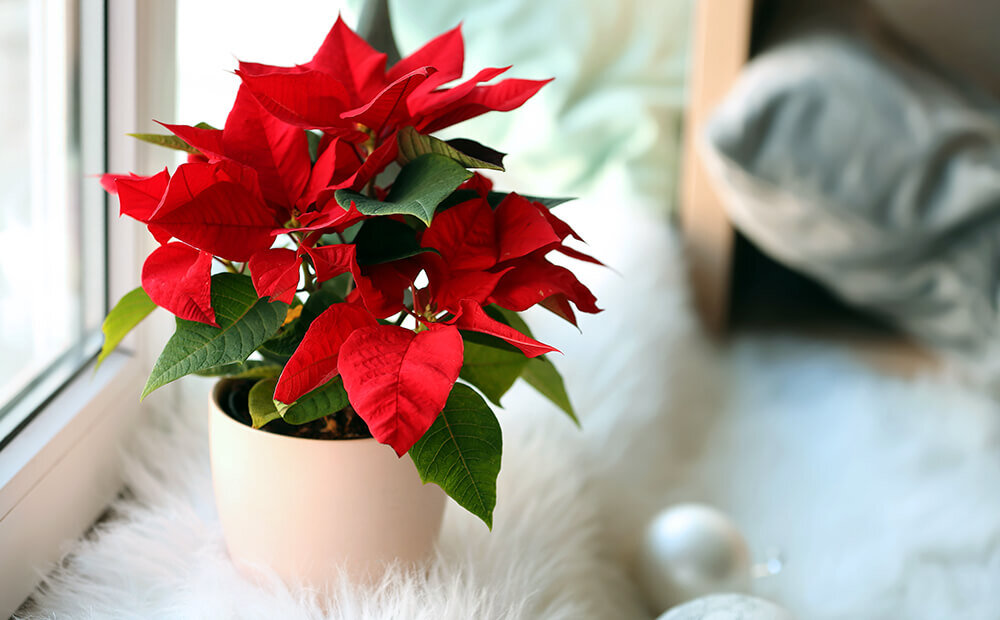CAN YOU KEEP POINSETTIAS AS HOUSEPLANTS?
What's a person to do with poinsettia when Christmas is over? Don't toss them out into the freezing Indianapolis weather with your garbage. Keep them as houseplants!
Yes, you can keep your Christmas poinsettias as houseplants, and you can even get them to bloom again next year.
The colored parts of the poinsettia aren't actually the flowers; they're colored leaves called bracts. The flowers are tiny little clusters of flowers where the colored leaves meet.
Here's what you need to know to keep your poinsettia as part of your houseplant family all year long and how to get it ready to bloom again in time for the holidays.
HOW TO TAKE CARE OF A POINSETTIA PLANT
Poinsettias are a tropical plant, so they need similar care to most other tropical houseplants in the winter. They like:
Lots of bright light, at least 6 hours per day, although not too much direct sun.
Temperatures between 65-70º during the day, slightly lower at night,
Moist, but not wet, soil with excellent drainage. Water your poinsettia when the soil feels dry on top or when the pot feels light.
Pots with drainage holes to prevent any standing water.
Poinsettias don't like:
Drafts, whether hot or cold. Keep them away from heat vents, doors, and drafty windows.
Sitting in water. It will make their roots rot! Make sure to remove any excess water from the catch tray.
A few weeks after Christmas, your poinsettia may start to drop its flowers and colored leaves. This is normal; the plant naturally enters a little rest or dormancy period after it finishes blooming. Reduce how often you water it, only watering when the soil is dry to about 1 inch from the surface.
POINSETTIA PRUNING
In the spring and mid-summer, prune your poinsettia. Pruning will help to encourage bushier growth and keep the shrub more compact. In March or April, you can prune up to ⅓ of the total volume of the plant. Once new growth appears, increase watering frequency, and start fertilizing your poinsettia with regular houseplant fertilizer once per month.
In July or August, you can pinch back smaller leaves again over the whole plan to encourage bushier growth. Do not prune your poinsettia after September, however, or you may remove flower buds.
POINSETTIA BLOOMING
The colored parts of the poinsettia aren't actually the flowers; they're colored leaves called bracts. The flowers are tiny little clusters of flowers where the colored leaves meet. You can get your poinsettia's leaves to start changing color again by exposing the plant to long periods of complete darkness.
From mid-September to December, you'll need to make sure your poinsettia gets 13-16 hours of complete darkness per night. You can provide total darkness overnight by:
Moving your poinsettia to a closet, windowless bathroom, or basement.
Covering your poinsettia with a large cardboard box.
Covering your poinsettia with a fully opaque bag, like a paper grocery bag or a sturdy reusable bag.
You may want to set alarms on your phone to remind you when to cover and uncover your poinsettia. Continue the nightly darkness regiment until early December to make sure lots of leaves turn color.
CAN POINSETTIAS BE PLANTED OUTSIDE?
You can move your poinsettia outside for the summer once nighttime temperatures are consistently above 55º. Transition your poinsettia slowly to outside life. Give them a spot that gets a bit of sun for part of the day, and make sure to check if they need water more frequently; outdoor plants may dry out much faster outside because of the wind and sun.
Bring them back inside once nighttime temperatures are consistently around 55º again. Over time, poinsettias can turn into a reasonably large shrub. You can plant them in the ground, but it is quite a bit of extra hassle. They won't survive the winter, so you'll have to dig them up to bring them back indoors. If you want to keep them for next year's holiday season, it's best to keep them in a pot.
If your poinsettia grows quite a bit over the summer, you may need to repot it when you bring it back indoors. While repotting, check the plant thoroughly for signs of pests, and make sure to quarantine the poinsettia in a room by itself for a few weeks when you bring it in.
ARE POINSETTIA PLANTS POISONOUS?
No, the poinsettia is NOT poisonous for people or pets. This is a myth that has circulated for many years. However, as a member of the euphorbia family, poinsettia stems contain a milky sap that can cause skin irritation. If your dog or child were to eat the whole plant, they'd probably have a stomach ache, but it's nothing to worry about.
Haven’t picked up your poinsettia yet? Hurry to our garden center before these classic Christmas plants get snatched up!






